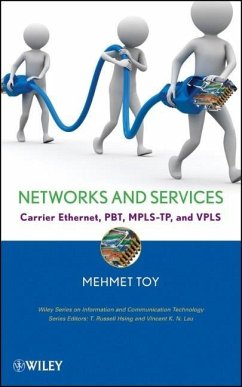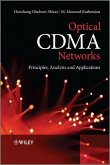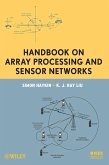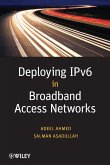- Gebundenes Buch
- Merkliste
- Auf die Merkliste
- Bewerten Bewerten
- Teilen
- Produkt teilen
- Produkterinnerung
- Produkterinnerung
This book provides a comprehensive understanding of current and debated future networking technologies. It gives insight into building end-to-end networks and services with Carrier Ethernet, PBT, MPLS-TP, and VPLS while also shedding light on the pros and cons of these technologies for service providers and enterprise network owners.
Focusing on layer-2 networking and services, Networks and Services covers: The basics of Ethernet such as protocol stack, bridges, switches, and hubs Key techniques that are being used in building carrier-class Carrier Ethernet networks and services like…mehr
Andere Kunden interessierten sich auch für
![Optical Cdma Networks Optical Cdma Networks]() M. Massoud KarbassianOptical Cdma Networks106,99 €
M. Massoud KarbassianOptical Cdma Networks106,99 €![Connected Services Connected Services]() Paul GoldingConnected Services87,99 €
Paul GoldingConnected Services87,99 €![Next Generation IPTV Services and Technologies Next Generation IPTV Services and Technologies]() Gerard O'DriscollNext Generation IPTV Services and Technologies147,99 €
Gerard O'DriscollNext Generation IPTV Services and Technologies147,99 €![Self-Organization in Sensor and Actor Networks Self-Organization in Sensor and Actor Networks]() Falko DresslerSelf-Organization in Sensor and Actor Networks124,99 €
Falko DresslerSelf-Organization in Sensor and Actor Networks124,99 €![Personal Networks Personal Networks]() Martin JacobssonPersonal Networks113,99 €
Martin JacobssonPersonal Networks113,99 €![Handbook on Array Processing and Sensor Networks Handbook on Array Processing and Sensor Networks]() Simon HaykinHandbook on Array Processing and Sensor Networks263,99 €
Simon HaykinHandbook on Array Processing and Sensor Networks263,99 €![Deploying Ipv6 in Broadband Access Networks Deploying Ipv6 in Broadband Access Networks]() Adeel AhmedDeploying Ipv6 in Broadband Access Networks90,99 €
Adeel AhmedDeploying Ipv6 in Broadband Access Networks90,99 €-
-
-
This book provides a comprehensive understanding of current and debated future networking technologies. It gives insight into building end-to-end networks and services with Carrier Ethernet, PBT, MPLS-TP, and VPLS while also shedding light on the pros and cons of these technologies for service providers and enterprise network owners.
Focusing on layer-2 networking and services, Networks and Services covers:
The basics of Ethernet such as protocol stack, bridges, switches, and hubs
Key techniques that are being used in building carrier-class Carrier Ethernet networks and services like synchronization, pseudowires, and protection
Carrier Ethernet network architectures and services that are currently deployed in the industry
Traffic management and OAM capabilities of Carrier Ethernet
Circuit Emulation Services
PBB and PBT to resolve possible scalability issues of Carrier Ethernet
Technologies that are competing or working with Carrier Ethernet in forming data networks and services, Transport MPLS, MPLS Transport Profile, and VPLS
Networks and Services: Carrier Ethernet, PBT, MPLS-TP, and VPLS is ideal for network architects, engineers, and planning professionals in telecommunications, as well as students and researchers in related disciplines.
Hinweis: Dieser Artikel kann nur an eine deutsche Lieferadresse ausgeliefert werden.
Focusing on layer-2 networking and services, Networks and Services covers:
The basics of Ethernet such as protocol stack, bridges, switches, and hubs
Key techniques that are being used in building carrier-class Carrier Ethernet networks and services like synchronization, pseudowires, and protection
Carrier Ethernet network architectures and services that are currently deployed in the industry
Traffic management and OAM capabilities of Carrier Ethernet
Circuit Emulation Services
PBB and PBT to resolve possible scalability issues of Carrier Ethernet
Technologies that are competing or working with Carrier Ethernet in forming data networks and services, Transport MPLS, MPLS Transport Profile, and VPLS
Networks and Services: Carrier Ethernet, PBT, MPLS-TP, and VPLS is ideal for network architects, engineers, and planning professionals in telecommunications, as well as students and researchers in related disciplines.
Hinweis: Dieser Artikel kann nur an eine deutsche Lieferadresse ausgeliefert werden.
Produktdetails
- Produktdetails
- Information and Communication Technology Vol.1
- Verlag: Wiley & Sons
- 1. Auflage
- Seitenzahl: 432
- Erscheinungstermin: 16. Oktober 2012
- Englisch
- Abmessung: 244mm x 161mm x 30mm
- Gewicht: 724g
- ISBN-13: 9780470391198
- ISBN-10: 0470391197
- Artikelnr.: 33392061
- Herstellerkennzeichnung
- Libri GmbH
- Europaallee 1
- 36244 Bad Hersfeld
- gpsr@libri.de
- Information and Communication Technology Vol.1
- Verlag: Wiley & Sons
- 1. Auflage
- Seitenzahl: 432
- Erscheinungstermin: 16. Oktober 2012
- Englisch
- Abmessung: 244mm x 161mm x 30mm
- Gewicht: 724g
- ISBN-13: 9780470391198
- ISBN-10: 0470391197
- Artikelnr.: 33392061
- Herstellerkennzeichnung
- Libri GmbH
- Europaallee 1
- 36244 Bad Hersfeld
- gpsr@libri.de
MEHMET TOY, PhD, is a Distinguished Engineer at Comcast and represents the company in the Metro Ethernet Forum (MEF) and IEEE standards. Previously, he held management and technical positions at ADVA Optical Networking, Intel Corporation, Verizon Wireless, Axiowave Networks, Fujitsu Network Communications, AT&T Bell Labs, and Lucent Technologies. Dr. Toy contributed to the research, development and standardization of various telecommunication technologies including IP Multimedia System (IMS), Asynchronous Transfer Mode (ATM), optical, IP/MPLS, and wireless. He has authored multiple books in these areas and various articles in data networking and signal processing, and has taught at universities as a tenure-track and adjunct faculty member.
Foreword xiii
Preface xv
1 Introduction and Overview 1
1.1 Introduction 1
1.2 Basic Ethernet 2
1.3 Synchronization 2
1.4 Pseudowires 2
1.5 Protection 2
1.6 Carrier Ethernet Architecture and Services 3
1.7 Carrier Ethernet Traffic Management 4
1.8 Ethernet Operations, Administrations, and Maintenance (OAM) 5
1.9 Circuit Emulation 6
1.10 Ethernet Local Management Interface (ELMI) 7
1.11 PBT 8
1.12 T-MPLS and MPLS-TP 9
1.13 Virtual Private LAN Services (VPLS) 11
2 Basic Ethernet 14
2.1 Introduction 14
2.2 CSMA/CD 15
2.3 Full Duplex, Pause, Autonegotiation 16
2.4 Repeaters and Hubs 16
2.5 Bridges 17
2.6 Switches 18
2.7 Physical Layer 19
2.8 Temperature Hardening 26
2.9 Standards 27
2.10 Ethernet Frame Types and the Ethertype Field 27
2.11 Conclusion 32
References 32
3 Synchronization 33
3.1 Introduction 33
3.2 Application Requirements 35
3.3 Synchronization Standards 39
3.4 NTP/SNTP 40
3.5 Precision Time Protocol (IEEE 1588) 44
3.6 Synchronous-Ethernet Networks (SyncE) 51
3.7 Conclusion 61
References 61
4 Pseudowires 63
4.1 Introduction 63
4.2 Protocol Layers 63
4.3 Payload Types 64
4.4 Pseudowire Architecture 65
4.5 Control Plane 72
4.6 Multisegment Architecture 74
4.7 Multisegment Pseudowire Setup Mechanisms 77
4.8 Resiliency 80
4.9 Quality of Service and Congestion Control 80
4.10 Operations and Maintenance (OAM) 81
4.11 Security 83
4.12 Conclusion 84
References 85
5 Ethernet Protection 86
5.1 Introduction 86
5.2 Automatic Protection Switching (APS) Entities 87
5.3 Linear Protection 89
5.4 Ring Protection 97
5.5 Link Aggregation 102
5.6 Conclusion 108
References 108
6 Carrier Ethernet Architectures and Services 109
6.1 Introduction 109
6.2 Standards 111
6.3 Architecture 111
6.4 Interfaces 125
6.5 Services 138
6.6 Conclusion 156
References 156
7 Carrier Ethernet Traffic Management 158
7.1 Introduction 158
7.2 Policing 160
7.3 Queuing, Scheduling, and Flow Control 161
7.4 Three CoS Model 161
7.5 SLAs (Service-Level Agreements) 164
7.6 SLAs 168
7.7 Application-CoS-Priority Mapping 168
7.8 Bandwidth Profile 177
7.9 Conclusion 180
References 180
8 Carrier Ethernet OAM&P (Operations, Administration, Management, and
Performance) 181
8.1 Introduction 181
8.2 Link OAM 183
8.3 Service OAM 186
8.4 Maintenance Entities 188
8.5 Maintenance Points 190
8.6 OAM Addressing and Frame Format 193
8.7 Continuity Check Message (CCM) 198
8.8 Loopback and Reply Messages (LBM and LBR) 202
8.9 Link Trace and Reply Messages (LTM and LTR) 206
8.10 Ethernet Alarm Indication Signal (ETH-AIS) 210
8.11 Ethernet Remote Defective Indication (ETH-RDI) 213
8.12 Ethernet Locked Signal (ETH-LCK) 214
8.13 Performance Measurements 215
8.14 Performance Monitoring 217
8.15 Loss Measurements 218
8.16 Availability 221
8.17 Frame Delay Measurements 224
8.18 Interframe Delay Variation (IFDV) Measurements 225
8.19 Testing 225
8.20 Security 232
8.21 OAM Bandwidth 232
8.22 Conclusion 233
References 233
9 Circuit Emulation Services (CES) 234
9.1 Introduction 234
9.2 Circuit Emulation Functions 237
9.3 Adaptation Function Headers 238
9.4 Synchronization 241
9.5 TDM Application Signaling 242
9.6 CESoETH Defects and Alarms 244
9.7 Performance Monitoring of CESoETH 245
9.8 CESoETH Service Configuration 245
9.9 Conclusion 246
References 246
10 Carrier Ethernet Local Management Interface 247
10.1 Introduction 247
10.2 ELMI Messages 250
10.3 ELMI Message Elements 252
10.4 ELMI System Parameters and Procedures 257
10.5 UNI-C AND N Procedures 260
10.6 Conclusion 261
References 261
11 PB (Provider Bridges), PBB (Provider Backbone Bridges), and PBT
(Provider Backbone Transport) 262
11.1 Introduction 262
11.2 IEEE 802.1AB 264
11.3 Provider Backbone Bridges (PBB) 270
11.4 PBT (Provider Backbone Transport) 278
11.5 Conclusion 287
References 287
12 T-MPLS (Transport MPLS) 288
12.1 Introduction 288
12.2 Differences from MPLS 290
12.3 Architecture 291
12.4 T-MPLS Frame Structure 294
12.5 T-MPLS Networks 296
12.6 Conclusion 301
References 302
13 MPLS-TP(MPLS-Transport Profile) 303
13.1 Introduction 303
13.2 Frame Format 306
13.3 Architecture 307
13.4 OAM (Operations, Administration, and Maintenance) 320
13.5 Protection Switching 330
13.6 Security Considerations 331
13.7 Conclusion 331
References 331
14 Virtual Private LAN Services (VPLS) 333
14.1 Introduction 333
14.2 Data Plane 338
14.3 LDP-Based VPLS 340
14.4 BGP Approach 353
14.5 Security 360
14.6 External Network-Network Interface 360
14.7 Conclusion 360
References 361
Index 363
Preface xv
1 Introduction and Overview 1
1.1 Introduction 1
1.2 Basic Ethernet 2
1.3 Synchronization 2
1.4 Pseudowires 2
1.5 Protection 2
1.6 Carrier Ethernet Architecture and Services 3
1.7 Carrier Ethernet Traffic Management 4
1.8 Ethernet Operations, Administrations, and Maintenance (OAM) 5
1.9 Circuit Emulation 6
1.10 Ethernet Local Management Interface (ELMI) 7
1.11 PBT 8
1.12 T-MPLS and MPLS-TP 9
1.13 Virtual Private LAN Services (VPLS) 11
2 Basic Ethernet 14
2.1 Introduction 14
2.2 CSMA/CD 15
2.3 Full Duplex, Pause, Autonegotiation 16
2.4 Repeaters and Hubs 16
2.5 Bridges 17
2.6 Switches 18
2.7 Physical Layer 19
2.8 Temperature Hardening 26
2.9 Standards 27
2.10 Ethernet Frame Types and the Ethertype Field 27
2.11 Conclusion 32
References 32
3 Synchronization 33
3.1 Introduction 33
3.2 Application Requirements 35
3.3 Synchronization Standards 39
3.4 NTP/SNTP 40
3.5 Precision Time Protocol (IEEE 1588) 44
3.6 Synchronous-Ethernet Networks (SyncE) 51
3.7 Conclusion 61
References 61
4 Pseudowires 63
4.1 Introduction 63
4.2 Protocol Layers 63
4.3 Payload Types 64
4.4 Pseudowire Architecture 65
4.5 Control Plane 72
4.6 Multisegment Architecture 74
4.7 Multisegment Pseudowire Setup Mechanisms 77
4.8 Resiliency 80
4.9 Quality of Service and Congestion Control 80
4.10 Operations and Maintenance (OAM) 81
4.11 Security 83
4.12 Conclusion 84
References 85
5 Ethernet Protection 86
5.1 Introduction 86
5.2 Automatic Protection Switching (APS) Entities 87
5.3 Linear Protection 89
5.4 Ring Protection 97
5.5 Link Aggregation 102
5.6 Conclusion 108
References 108
6 Carrier Ethernet Architectures and Services 109
6.1 Introduction 109
6.2 Standards 111
6.3 Architecture 111
6.4 Interfaces 125
6.5 Services 138
6.6 Conclusion 156
References 156
7 Carrier Ethernet Traffic Management 158
7.1 Introduction 158
7.2 Policing 160
7.3 Queuing, Scheduling, and Flow Control 161
7.4 Three CoS Model 161
7.5 SLAs (Service-Level Agreements) 164
7.6 SLAs 168
7.7 Application-CoS-Priority Mapping 168
7.8 Bandwidth Profile 177
7.9 Conclusion 180
References 180
8 Carrier Ethernet OAM&P (Operations, Administration, Management, and
Performance) 181
8.1 Introduction 181
8.2 Link OAM 183
8.3 Service OAM 186
8.4 Maintenance Entities 188
8.5 Maintenance Points 190
8.6 OAM Addressing and Frame Format 193
8.7 Continuity Check Message (CCM) 198
8.8 Loopback and Reply Messages (LBM and LBR) 202
8.9 Link Trace and Reply Messages (LTM and LTR) 206
8.10 Ethernet Alarm Indication Signal (ETH-AIS) 210
8.11 Ethernet Remote Defective Indication (ETH-RDI) 213
8.12 Ethernet Locked Signal (ETH-LCK) 214
8.13 Performance Measurements 215
8.14 Performance Monitoring 217
8.15 Loss Measurements 218
8.16 Availability 221
8.17 Frame Delay Measurements 224
8.18 Interframe Delay Variation (IFDV) Measurements 225
8.19 Testing 225
8.20 Security 232
8.21 OAM Bandwidth 232
8.22 Conclusion 233
References 233
9 Circuit Emulation Services (CES) 234
9.1 Introduction 234
9.2 Circuit Emulation Functions 237
9.3 Adaptation Function Headers 238
9.4 Synchronization 241
9.5 TDM Application Signaling 242
9.6 CESoETH Defects and Alarms 244
9.7 Performance Monitoring of CESoETH 245
9.8 CESoETH Service Configuration 245
9.9 Conclusion 246
References 246
10 Carrier Ethernet Local Management Interface 247
10.1 Introduction 247
10.2 ELMI Messages 250
10.3 ELMI Message Elements 252
10.4 ELMI System Parameters and Procedures 257
10.5 UNI-C AND N Procedures 260
10.6 Conclusion 261
References 261
11 PB (Provider Bridges), PBB (Provider Backbone Bridges), and PBT
(Provider Backbone Transport) 262
11.1 Introduction 262
11.2 IEEE 802.1AB 264
11.3 Provider Backbone Bridges (PBB) 270
11.4 PBT (Provider Backbone Transport) 278
11.5 Conclusion 287
References 287
12 T-MPLS (Transport MPLS) 288
12.1 Introduction 288
12.2 Differences from MPLS 290
12.3 Architecture 291
12.4 T-MPLS Frame Structure 294
12.5 T-MPLS Networks 296
12.6 Conclusion 301
References 302
13 MPLS-TP(MPLS-Transport Profile) 303
13.1 Introduction 303
13.2 Frame Format 306
13.3 Architecture 307
13.4 OAM (Operations, Administration, and Maintenance) 320
13.5 Protection Switching 330
13.6 Security Considerations 331
13.7 Conclusion 331
References 331
14 Virtual Private LAN Services (VPLS) 333
14.1 Introduction 333
14.2 Data Plane 338
14.3 LDP-Based VPLS 340
14.4 BGP Approach 353
14.5 Security 360
14.6 External Network-Network Interface 360
14.7 Conclusion 360
References 361
Index 363
Foreword xiii
Preface xv
1 Introduction and Overview 1
1.1 Introduction 1
1.2 Basic Ethernet 2
1.3 Synchronization 2
1.4 Pseudowires 2
1.5 Protection 2
1.6 Carrier Ethernet Architecture and Services 3
1.7 Carrier Ethernet Traffic Management 4
1.8 Ethernet Operations, Administrations, and Maintenance (OAM) 5
1.9 Circuit Emulation 6
1.10 Ethernet Local Management Interface (ELMI) 7
1.11 PBT 8
1.12 T-MPLS and MPLS-TP 9
1.13 Virtual Private LAN Services (VPLS) 11
2 Basic Ethernet 14
2.1 Introduction 14
2.2 CSMA/CD 15
2.3 Full Duplex, Pause, Autonegotiation 16
2.4 Repeaters and Hubs 16
2.5 Bridges 17
2.6 Switches 18
2.7 Physical Layer 19
2.8 Temperature Hardening 26
2.9 Standards 27
2.10 Ethernet Frame Types and the Ethertype Field 27
2.11 Conclusion 32
References 32
3 Synchronization 33
3.1 Introduction 33
3.2 Application Requirements 35
3.3 Synchronization Standards 39
3.4 NTP/SNTP 40
3.5 Precision Time Protocol (IEEE 1588) 44
3.6 Synchronous-Ethernet Networks (SyncE) 51
3.7 Conclusion 61
References 61
4 Pseudowires 63
4.1 Introduction 63
4.2 Protocol Layers 63
4.3 Payload Types 64
4.4 Pseudowire Architecture 65
4.5 Control Plane 72
4.6 Multisegment Architecture 74
4.7 Multisegment Pseudowire Setup Mechanisms 77
4.8 Resiliency 80
4.9 Quality of Service and Congestion Control 80
4.10 Operations and Maintenance (OAM) 81
4.11 Security 83
4.12 Conclusion 84
References 85
5 Ethernet Protection 86
5.1 Introduction 86
5.2 Automatic Protection Switching (APS) Entities 87
5.3 Linear Protection 89
5.4 Ring Protection 97
5.5 Link Aggregation 102
5.6 Conclusion 108
References 108
6 Carrier Ethernet Architectures and Services 109
6.1 Introduction 109
6.2 Standards 111
6.3 Architecture 111
6.4 Interfaces 125
6.5 Services 138
6.6 Conclusion 156
References 156
7 Carrier Ethernet Traffic Management 158
7.1 Introduction 158
7.2 Policing 160
7.3 Queuing, Scheduling, and Flow Control 161
7.4 Three CoS Model 161
7.5 SLAs (Service-Level Agreements) 164
7.6 SLAs 168
7.7 Application-CoS-Priority Mapping 168
7.8 Bandwidth Profile 177
7.9 Conclusion 180
References 180
8 Carrier Ethernet OAM&P (Operations, Administration, Management, and
Performance) 181
8.1 Introduction 181
8.2 Link OAM 183
8.3 Service OAM 186
8.4 Maintenance Entities 188
8.5 Maintenance Points 190
8.6 OAM Addressing and Frame Format 193
8.7 Continuity Check Message (CCM) 198
8.8 Loopback and Reply Messages (LBM and LBR) 202
8.9 Link Trace and Reply Messages (LTM and LTR) 206
8.10 Ethernet Alarm Indication Signal (ETH-AIS) 210
8.11 Ethernet Remote Defective Indication (ETH-RDI) 213
8.12 Ethernet Locked Signal (ETH-LCK) 214
8.13 Performance Measurements 215
8.14 Performance Monitoring 217
8.15 Loss Measurements 218
8.16 Availability 221
8.17 Frame Delay Measurements 224
8.18 Interframe Delay Variation (IFDV) Measurements 225
8.19 Testing 225
8.20 Security 232
8.21 OAM Bandwidth 232
8.22 Conclusion 233
References 233
9 Circuit Emulation Services (CES) 234
9.1 Introduction 234
9.2 Circuit Emulation Functions 237
9.3 Adaptation Function Headers 238
9.4 Synchronization 241
9.5 TDM Application Signaling 242
9.6 CESoETH Defects and Alarms 244
9.7 Performance Monitoring of CESoETH 245
9.8 CESoETH Service Configuration 245
9.9 Conclusion 246
References 246
10 Carrier Ethernet Local Management Interface 247
10.1 Introduction 247
10.2 ELMI Messages 250
10.3 ELMI Message Elements 252
10.4 ELMI System Parameters and Procedures 257
10.5 UNI-C AND N Procedures 260
10.6 Conclusion 261
References 261
11 PB (Provider Bridges), PBB (Provider Backbone Bridges), and PBT
(Provider Backbone Transport) 262
11.1 Introduction 262
11.2 IEEE 802.1AB 264
11.3 Provider Backbone Bridges (PBB) 270
11.4 PBT (Provider Backbone Transport) 278
11.5 Conclusion 287
References 287
12 T-MPLS (Transport MPLS) 288
12.1 Introduction 288
12.2 Differences from MPLS 290
12.3 Architecture 291
12.4 T-MPLS Frame Structure 294
12.5 T-MPLS Networks 296
12.6 Conclusion 301
References 302
13 MPLS-TP(MPLS-Transport Profile) 303
13.1 Introduction 303
13.2 Frame Format 306
13.3 Architecture 307
13.4 OAM (Operations, Administration, and Maintenance) 320
13.5 Protection Switching 330
13.6 Security Considerations 331
13.7 Conclusion 331
References 331
14 Virtual Private LAN Services (VPLS) 333
14.1 Introduction 333
14.2 Data Plane 338
14.3 LDP-Based VPLS 340
14.4 BGP Approach 353
14.5 Security 360
14.6 External Network-Network Interface 360
14.7 Conclusion 360
References 361
Index 363
Preface xv
1 Introduction and Overview 1
1.1 Introduction 1
1.2 Basic Ethernet 2
1.3 Synchronization 2
1.4 Pseudowires 2
1.5 Protection 2
1.6 Carrier Ethernet Architecture and Services 3
1.7 Carrier Ethernet Traffic Management 4
1.8 Ethernet Operations, Administrations, and Maintenance (OAM) 5
1.9 Circuit Emulation 6
1.10 Ethernet Local Management Interface (ELMI) 7
1.11 PBT 8
1.12 T-MPLS and MPLS-TP 9
1.13 Virtual Private LAN Services (VPLS) 11
2 Basic Ethernet 14
2.1 Introduction 14
2.2 CSMA/CD 15
2.3 Full Duplex, Pause, Autonegotiation 16
2.4 Repeaters and Hubs 16
2.5 Bridges 17
2.6 Switches 18
2.7 Physical Layer 19
2.8 Temperature Hardening 26
2.9 Standards 27
2.10 Ethernet Frame Types and the Ethertype Field 27
2.11 Conclusion 32
References 32
3 Synchronization 33
3.1 Introduction 33
3.2 Application Requirements 35
3.3 Synchronization Standards 39
3.4 NTP/SNTP 40
3.5 Precision Time Protocol (IEEE 1588) 44
3.6 Synchronous-Ethernet Networks (SyncE) 51
3.7 Conclusion 61
References 61
4 Pseudowires 63
4.1 Introduction 63
4.2 Protocol Layers 63
4.3 Payload Types 64
4.4 Pseudowire Architecture 65
4.5 Control Plane 72
4.6 Multisegment Architecture 74
4.7 Multisegment Pseudowire Setup Mechanisms 77
4.8 Resiliency 80
4.9 Quality of Service and Congestion Control 80
4.10 Operations and Maintenance (OAM) 81
4.11 Security 83
4.12 Conclusion 84
References 85
5 Ethernet Protection 86
5.1 Introduction 86
5.2 Automatic Protection Switching (APS) Entities 87
5.3 Linear Protection 89
5.4 Ring Protection 97
5.5 Link Aggregation 102
5.6 Conclusion 108
References 108
6 Carrier Ethernet Architectures and Services 109
6.1 Introduction 109
6.2 Standards 111
6.3 Architecture 111
6.4 Interfaces 125
6.5 Services 138
6.6 Conclusion 156
References 156
7 Carrier Ethernet Traffic Management 158
7.1 Introduction 158
7.2 Policing 160
7.3 Queuing, Scheduling, and Flow Control 161
7.4 Three CoS Model 161
7.5 SLAs (Service-Level Agreements) 164
7.6 SLAs 168
7.7 Application-CoS-Priority Mapping 168
7.8 Bandwidth Profile 177
7.9 Conclusion 180
References 180
8 Carrier Ethernet OAM&P (Operations, Administration, Management, and
Performance) 181
8.1 Introduction 181
8.2 Link OAM 183
8.3 Service OAM 186
8.4 Maintenance Entities 188
8.5 Maintenance Points 190
8.6 OAM Addressing and Frame Format 193
8.7 Continuity Check Message (CCM) 198
8.8 Loopback and Reply Messages (LBM and LBR) 202
8.9 Link Trace and Reply Messages (LTM and LTR) 206
8.10 Ethernet Alarm Indication Signal (ETH-AIS) 210
8.11 Ethernet Remote Defective Indication (ETH-RDI) 213
8.12 Ethernet Locked Signal (ETH-LCK) 214
8.13 Performance Measurements 215
8.14 Performance Monitoring 217
8.15 Loss Measurements 218
8.16 Availability 221
8.17 Frame Delay Measurements 224
8.18 Interframe Delay Variation (IFDV) Measurements 225
8.19 Testing 225
8.20 Security 232
8.21 OAM Bandwidth 232
8.22 Conclusion 233
References 233
9 Circuit Emulation Services (CES) 234
9.1 Introduction 234
9.2 Circuit Emulation Functions 237
9.3 Adaptation Function Headers 238
9.4 Synchronization 241
9.5 TDM Application Signaling 242
9.6 CESoETH Defects and Alarms 244
9.7 Performance Monitoring of CESoETH 245
9.8 CESoETH Service Configuration 245
9.9 Conclusion 246
References 246
10 Carrier Ethernet Local Management Interface 247
10.1 Introduction 247
10.2 ELMI Messages 250
10.3 ELMI Message Elements 252
10.4 ELMI System Parameters and Procedures 257
10.5 UNI-C AND N Procedures 260
10.6 Conclusion 261
References 261
11 PB (Provider Bridges), PBB (Provider Backbone Bridges), and PBT
(Provider Backbone Transport) 262
11.1 Introduction 262
11.2 IEEE 802.1AB 264
11.3 Provider Backbone Bridges (PBB) 270
11.4 PBT (Provider Backbone Transport) 278
11.5 Conclusion 287
References 287
12 T-MPLS (Transport MPLS) 288
12.1 Introduction 288
12.2 Differences from MPLS 290
12.3 Architecture 291
12.4 T-MPLS Frame Structure 294
12.5 T-MPLS Networks 296
12.6 Conclusion 301
References 302
13 MPLS-TP(MPLS-Transport Profile) 303
13.1 Introduction 303
13.2 Frame Format 306
13.3 Architecture 307
13.4 OAM (Operations, Administration, and Maintenance) 320
13.5 Protection Switching 330
13.6 Security Considerations 331
13.7 Conclusion 331
References 331
14 Virtual Private LAN Services (VPLS) 333
14.1 Introduction 333
14.2 Data Plane 338
14.3 LDP-Based VPLS 340
14.4 BGP Approach 353
14.5 Security 360
14.6 External Network-Network Interface 360
14.7 Conclusion 360
References 361
Index 363








